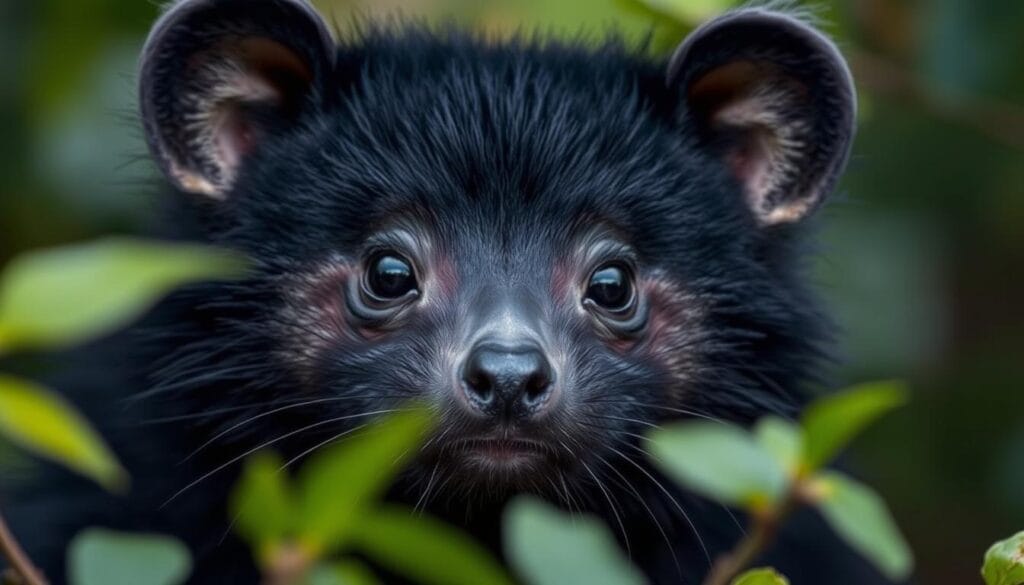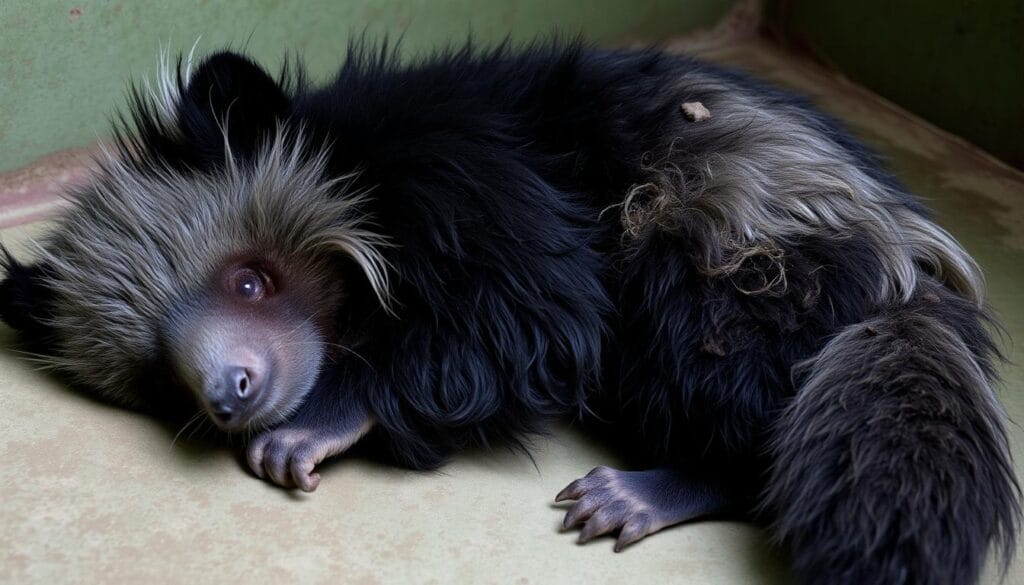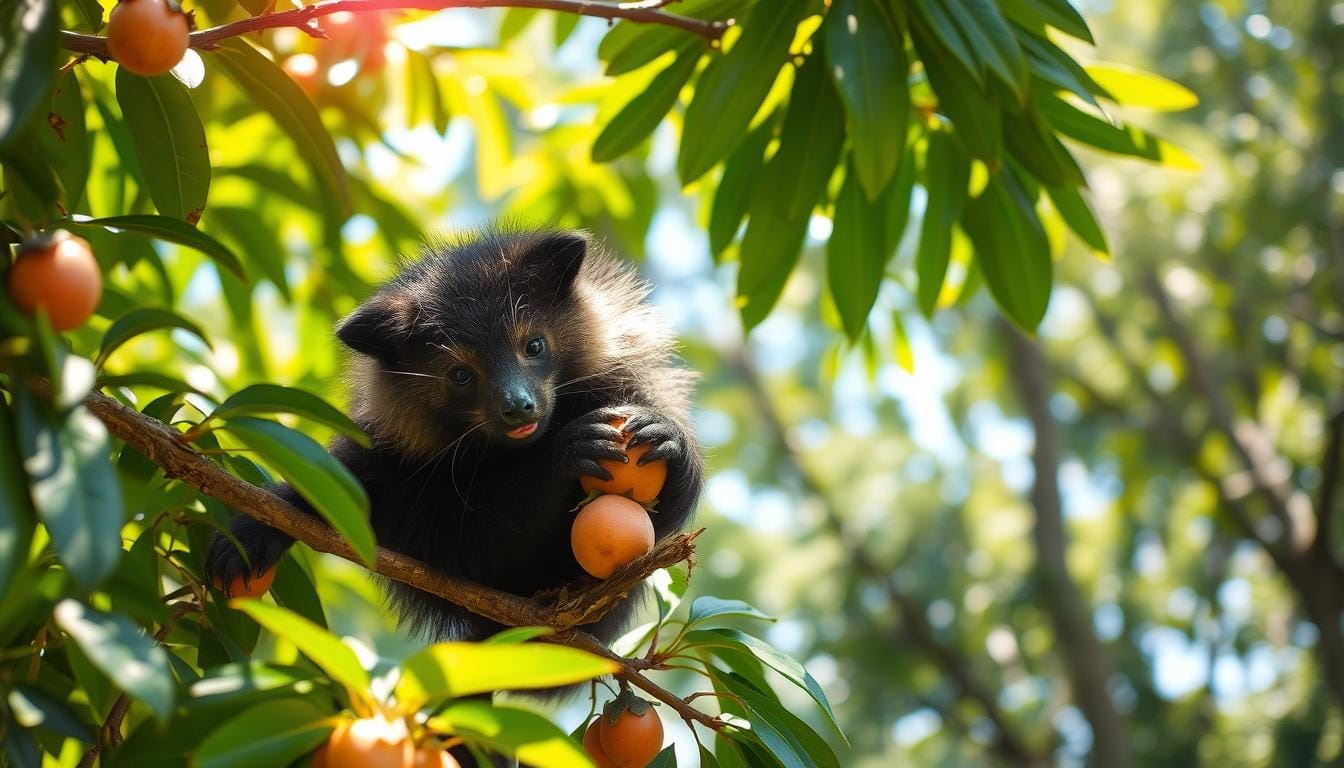As a binturong owner, you’ve probably noticed their popcorn-like scent in the air. You’ve also seen them climb with their long, prehensile tail. This tail is often longer than their body.
Behind their playful antics lies a creature shaped by thousands of years in Southeast Asian rainforests. Their survival depends on understanding their Binturong diet and health needs. These omnivores, from places like Indonesia’s Sumatra and Java, need figs, small mammals, and mental stimulation to thrive.
Yet, many in captivity face health problems from diets that don’t match their wild instincts. This article uses science from IUCN conservation and zoo vet practices. It aims to help you care for your binturong’s full potential.
Table of Contents
Understanding the Binturong: Nature’s Fruit-Loving Bearcat
Binturongs, also known as bearcats, are special mammals. They have cat-like agility and bear-like fur. Their shaggy black coat and prehensile tail show they are tree-dwellers, living in Southeast Asia’s rainforests. Knowing about their natural behaviors and needs helps with Binturong care tips and healthy Binturong feeding habits.
Physical Characteristics and Natural Habitat
These animals live in dense tropical forests. They use their tails like extra limbs to move through the trees. Key traits include:
- Body length: 60-96 cm (2-3 ft) with a tail as long as their body
- Weight: 9-20 kg (20-44 lbs), ideal for climbing
- A signature “popcorn-like” scent from oil glands
Wild Binturongs vs. Captive Binturongs
In the wild, these nocturnal omnivores eat fruits, eggs, and small animals. Captive binturongs need owners to provide a varied diet. Binturong care tips include:
- Providing vertical space (8ft height minimum)
- Offering varied diets to prevent boredom
- Regular veterinary checkups every 6-12 months
Why Diet is Critical for Binturong Wellbeing
Wild binturongs travel long distances to find food, but captive diets must match this balance. Bad Binturong feeding habits can cause obesity, dental problems, or digestive issues. Their survival in captivity depends on understanding their love for fruits and adapting their meals.
Natural Diet of Binturongs in the Wild
Binturongs mainly eat fruits, which is key to their survival. They love ripe figs and other soft fruits, making up over 60% of their diet. Fig trees are their favorite, with 87.5% of their meals near these trees.
Besides fruits, they also eat small animals like insects, rodents, and birds. This adds protein to their diet, keeping it balanced. They use their strong smell to find the ripest fruits for the best nutrition.
Their eating habits affect the forest. By eating fruits whole and spreading seeds, they help forests grow. Their role in seed dispersal is crucial for Southeast Asian rainforests.
- Fruits: Figs, mangoes, and durians make up 60–80% of their diet.
- Protein sources: Birds, eggs, and insects supplement their meals.
- Adaptations: Their prehensile tails and climbing skills help reach canopy fruits.
Zoos like the Nashville Zoo try to mimic their natural diet. In 2023, they donated to conservation and started breeding programs. Their efforts help protect this endangered species. Preserving their fruit-rich habitats is essential for their survival.
Essential Nutritional Requirements for Captive Binturongs
Meeting the Binturong nutritional needs is all about balance. They need 15–25% protein daily to keep muscles strong and immune system working. In the wild, they eat insects and small animals. But, in captivity, they can have lean meats, eggs, or mealworms.
Too much protein can lead to obesity. Not enough can cause muscle loss.
Protein Sources and Requirements
- Provide 15–25% of daily calories from lean meats like chicken or fish.
- Include eggs and insects to supply complete amino acids.
- Avoid excessive red meats to prevent calcium imbalances.
Carbohydrates and Fiber Needs
Wild binturongs eat mostly figs. Captive diets should have fibrous fruits like bananas and papayas. They need 10–15% of calories from complex carbs and 5–7% insoluble fiber for good digestion. But, limit sugary fruits to avoid diabetes.
Fat Requirements and Sources
5–15% of calories should come from fats. Choose omega-3 rich sources like fish oil. Avoid saturated fats to prevent obesity. Eggs and lean meats are good for healthy fats and vitamin absorption.
Vitamin and Mineral Balance
- Calcium and phosphorus must be balanced at a 1:1 ratio to prevent bone disorders.
- Vitamins A and D are critical for skin and vision health.
- Zinc and selenium supplements may be needed in controlled diets.
Regular vet visits and diet changes are key for Binturong diet and health. Watch their weight and stool to catch any issues early. Make sure their diet is varied and natural, avoiding processed foods.
Binturong Diet and Health: Creating an Optimal Feeding Plan
Creating a Binturong diet and health plan is a mix of science and watching your pet. First, figure out how many calories your binturong needs. Juveniles need 120-150 calories per kg, while adults need 100-120. Taronga Zoo feeds their binturongs 2-8 kg of food daily, split into two meals.
Use this info to make meals fit your binturong’s age and how active it is.
- Adults: 10% body weight in fruits (papaya, bananas) and 20% protein (chicken)
- Juveniles: Add 10% more protein for growth
- Geriatrics: Reduce calories by 15% to prevent obesity
“Bianca’s keepers adjusted her diet after noticing reduced activity levels, boosting her fruit intake by 15% to match her enclosure’s climbing opportunities.”
Daily Caloric Needs Based on Age and Activity
Binturongs that are very active might need 5-10% more calories. Check their body condition score every month. A healthy binturong should have muscle tone but no extra fat. If they gain or lose 10% body weight in a month, adjust their food.
Balancing Macronutrients for Optimal Health
Protein should be 25% of their meals, from cooked chicken or eggs (3 times a week). Fruits like figs should make up 50% of their diet. Add vegetables and insects for fiber. For example, a 15kg adult might eat 450g fruit, 300g protein, and 250g greens daily. Change up their food weekly to keep them interested.
Seasonal Adjustments to Your Binturong’s Diet
In winter, cut down fruit by 15% because they’re less active. Increase protein in breeding seasons—males might need 20% more chicken. Check their stool weekly; if it’s too loose, they’re eating too much. If it’s too hard, add more fiber slowly.
Always talk to a vet before changing their diet. Regular health checks every 3 months help keep their diet on track. Make changes slowly—over 7-10 days—to avoid upsetting their stomach.
Recommended Foods for Your Bearcat
Understanding Binturong food choices starts with their natural instincts. In captivity, 60–70% of their diet should include ripe fruits like figs, papaya, mango, and berries. These provide vitamins and hydration. Avoid overfeeding high-sugar fruits like bananas unless paired with leafy greens.
Protein makes up 20–30% of their meals. Offer cooked chicken, turkey, or rabbit. Eggs and insect protein pellets add variety. Always cook meats thoroughly to prevent parasites. For enrichment, hide small portions of protein in puzzle feeders to mimic foraging.
- Fruits: Rotate figs, melons, and apples to avoid boredom.
- Proteins: Serve lean meats 3–4 times weekly. Limit fatty cuts.
- Supplements: Use commercial exotic animal pellets as a base, then add fresh foods.
Binturong care tips include monitoring portion sizes. A 30-pound adult like Bianca at the Louisville Zoo needs 2–3 meals daily. Cut fruits into bite-sized pieces to prevent choking. Clean feeding areas daily to avoid mold growth.
Always wash produce and remove seeds/pits. Rotate foods weekly to prevent picky eating. Consult a vet before introducing new items. Puzzle feeders and scattered meals encourage natural behaviors, reducing stress.
Foods to Avoid: Potential Toxins and Allergens

Keeping your binturong safe from harmful foods is key to their health. Binturong health concerns often come from eating things they shouldn’t. Follow safe Binturong care tips to steer clear of emergencies.
Common Toxic Foods for Binturongs
Avoid these dangerous items entirely:
- Chocolate: Contains theobromine, which damages the heart and nervous system.
- Caffeine: Overstimulates the cardiovascular system.
- Alcohol: Damages liver and brain function.
- Avocado pits/skin: Persin toxin causes respiratory distress.
- Onions/garlic: Damage red blood cells leading to anemia.
- Grapes/raisins: Kidney failure risk.
- Xylitol: Triggers insulin spikes and liver failure.
| Toxin | Impact | Safe Substitutes |
|---|---|---|
| Chocolate | Neurological damage | Apple slices |
| Alcohol | Organ failure | Cucumber sticks |
| Onions | Internal bleeding | Pumpkin puree |
Signs of Food Allergies or Sensitivities
Watch for these indicators:
- Swelling around the face or paws
- Diarrhea or vomiting
- Excessive itching or skin redness
- Labored breathing
Emergency Steps for Toxic Exposure
If your binturong eats something harmful:
- Call the ASPCA Animal Poison Control (888-426-4435) immediately
- Save any food packaging for reference
- Do not induce vomiting unless instructed by a vet
- Have ready: species, weight, and time of exposure
Always keep emergency contacts handy. The Louisville Zoo’s AZA-accredited care protocols offer vital guidelines for such situations. Regular vet visits help prevent long-term Binturong health concerns.
Feeding Schedule and Portion Control
Feeding your binturong at night helps keep them healthy. Wild binturongs hunt at night, so your pet should eat then too. Start with evening meals to match their natural cycle. A set schedule helps avoid overfeeding, which is important for their care.
Frequency by Age
- Juveniles (under 2 years): Feed them 3-4 small meals a day to help them grow. Watch their weight to prevent obesity.
- Adults (over 2 years): Give them 1-2 meals at night. Check their weight and adjust food amounts as needed.
Portion Sizes
Adult binturongs need 3-5% of their body weight in food each day. For example, a 30-pound binturong needs 0.9–1.5 pounds of food. Use fruit sizes to guide food portions. Keep a feeding log to stay consistent.
Food Presentation Techniques
Make mealtime fun by hiding food in branches or puzzle feeders. Spread out fruits and proteins in their space to encourage climbing. Change how you present food weekly to keep them interested. Make sure food is placed in calm areas to reduce stress.
Hydration Needs and Water Requirements
Keeping your binturong hydrated is crucial. Even if they eat a lot of fruit, they still need clean water every day. Aim for 60–80ml of water for each kilogram of their body weight. For example, a 10kg binturong needs 600–800ml of water, adjusting based on their activity and the temperature.
- Use shallow bowls or drip systems to mimic natural water sources.
- Replace water daily and scrub containers weekly to avoid bacteria.
- Position bowls in shaded areas to keep water cool and fresh.
Look out for signs of dehydration like sunken eyes, dry skin, or dark urine. These are clear signs that your binturong needs water right away. If they won’t drink, try giving them an electrolyte solution.
| Weight (kg) | Water Needed (ml/day) |
|---|---|
| 9–12 | 540–960 |
| 13–16 | 780–1,280 |
| 17–20 | 1,020–1,600 |
In captivity, shallow pools can serve as both a place to drink and play. Swimming helps them cool down and have fun. But, make sure to keep their drinking water separate from the pool. This is even more important during hot months, for larger binturongs weighing 20kg or more.
For more tips on exotic pet hydration, check out how to care for newborn squirrels. It offers more ideas on keeping your pet hydrated.
Stay alert: dehydrated binturongs might seem tired or less active. Keep an eye on how much water they drink and how much fruit they eat. This helps prevent serious health issues like kidney problems.
Common Health Issues Related to Poor Diet

Keeping your Binturong diet and health in check means avoiding diet-related problems. A 2024 study showed wild binturongs eat mostly fruits and do well. But, in captivity, they face Binturong health concerns due to bad diets.
Binturongs exhibit the lowest trophic position among studied species, relying almost entirely on plant-based diets. – 2024 Study
- Obesity: Eating too much sugar or fat can make them gain weight. Use body condition scoring to check their fat levels. Cut down on calories and encourage climbing to avoid joint and heart problems.
- Dental Damage: Eating soft, sticky foods can cause plaque. Give them crunchy fruits like apples to clean their teeth. Get yearly dental checks to catch gum disease early.
- Digestive Issues: Changing their diet too fast can upset their digestion. Slowly introduce new foods over two weeks to avoid diarrhea or constipation. Focus on high-fiber fruits like papaya and figs.
- Nutrient Deficiencies: Not getting enough vitamin A can weaken their immune system and vision. Give them leafy greens and fortified pellets. Talk to vets about supplements to avoid calcium shortages and metabolic bone disease.
Regular vet visits and adjusting their diet can help avoid these health risks. Wild binturongs don’t face these problems because they forage naturally. Captive care needs to mimic this natural balance.
Dietary Supplements: When and How to Use Them
Meeting Binturong nutritional needs is all about balance. Always get vet advice before adding supplements. Wild binturongs get minerals from salt licks, like in Malaysian reserves. Captive care must match this with vet-approved choices.
- During stress periods like relocation or illness recovery
- For aging binturongs needing extra calcium
- When zoo diets lack trace minerals found in wild fruit
- During pregnancy or lactation for energy demands
Vets often recommend:
- Calcium supplements with correct Ca:Phosphorus ratios
- Vitamin A/D3 sprays for skin health
- Omega-3 oils for coat shine (like those used at Taronga Zoo)
- Probiotics to aid digestion
At Semarang Zoo, binturongs get probiotics mixed with bananas twice weekly. Always follow label dosages adjusted for your animal’s weight. Over-supplementation risks kidney stress, so blood tests every six months are vital. The DWNP’s artificial salt licks show mineral balance matters—your vet may suggest adding trace minerals like zinc or magnesium.
Similar principles apply to other exotics, but binturongs need specialized care. Never use human supplements without guidance. Proper Binturong husbandry practices prioritize whole foods first, using supplements only as directed. Regular vet checkups ensure your pet stays healthy.
Monitoring Your Binturong’s Health Through Diet
Regular diet monitoring helps prevent Binturong health concerns. Watching for weight, stool, and coat changes is key. Here are Binturong care tips for proactive health management.
Weight tracking starts with weekly checks for juveniles and monthly for adults. Use a scale and note trends. A body condition score (1-5) helps assess if your binturong is underweight, ideal, or overweight. Rapid weight loss may signal digestive problems, while sudden gains could indicate overfeeding.
Stool analysis reveals dietary impacts. Healthy stools are firm, dark brown, and consistent. Loose, discoloredation, or bloody stools require vet checks. Keep a log of frequency and appearance to spot patterns.
- Normal: Firm, moist, brown (1-2x daily)
- Concern: Watery, mucus, or foreign particles
Cover coat and skin condition weekly. A glossy coat with no dandruff indicates proper nutrition. Dry fur, bald patches, or scabs might point to vitamin deficiencies or parasites. Brushing helps spot issues early.
“Regular vet checkups every 6-12 months help catch health risks early,” advises Louisville Zoo staff. “Monitor diet response to ensure they’re eating 70% fruits plus protein sources.”
Keep a health journal to track weight, stool, and coat notes. Compare entries with your binturong’s baseline. Adjust diets or consult a vet if abnormalities persist. Annual vet visits, as they age, ensure long-term well-being.
Conclusion: Ensuring Your Binturong Thrives Through Proper Nutrition and Care
Proper nutrition is key to a Binturong’s long and healthy life. A balanced diet of fruits, proteins, and fiber is essential. It helps them live up to 20–25 years in captivity, just like in the wild.
Following Binturong care tips, like feeding them a variety of fruits and controlling portions, is important. It helps prevent obesity and dental problems. Their unique scent and prehensile tails also benefit from a balanced diet.
Wild Binturongs face dangers like deforestation and illegal trade. Captive care is vital for their survival. Places like the Palawan Wildlife Rescue and Conservation Center stress the importance of proper feeding.
Regular vet visits and monitoring their weight are also crucial. This ensures they stay healthy and exhibit natural behaviors like climbing and seed dispersal. Each meal choice plays a big role in their health and survival.
A healthy diet is more than just food—it’s about creating a wild-like environment. By focusing on their nutritional needs, you help them stay active and healthy. This approach not only improves their life but also supports conservation efforts.

